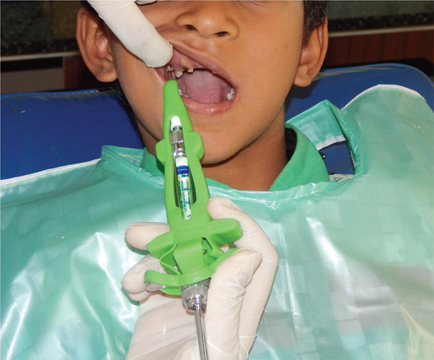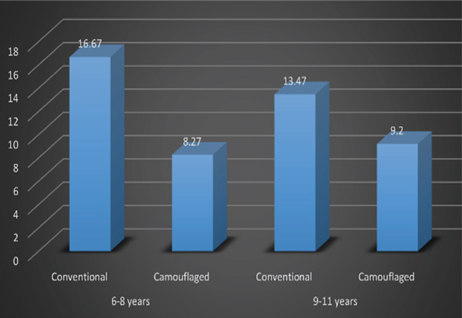J Dent Anesth Pain Med.
2018 Feb;18(1):35-40. 10.17245/jdapm.2018.18.1.35.
A clinical comparative study between conventional and camouflaged syringes to evaluate behavior and anxiety in 6–11-year-old children during local anesthesia administration—a novel approach
- Affiliations
-
- 1Pedodontics and Preventive Dentistry, M.R Ambedkar Dental College and Hospital, Bangalore, karnataka, India. anj2806@gmail.com
- KMID: 2405381
- DOI: http://doi.org/10.17245/jdapm.2018.18.1.35
Abstract
- BACKGROUND
The sight of dental injection can bring about severe anxiety in children. Therefore, an alternative method that is convenient, effective, and keeps the needle hidden making it child friendly is necessary. The objective of the study was to compare the efficacy of a camouflaged syringe and conventional syringe on behavior and anxiety in 6-11-year-old children during local anesthesia administration.
METHODS
The study was a randomized, crossover clinical study including 30 children. Children were separated into two groups. Group 1 consisted of 15 children aged 6-8 years while group 2 consisted of 15 children aged 9-11 years. This study involved two sessions wherein all the children were injected using conventional and camouflaged syringes in separate sessions. Their behavior was assessed using the Faces, Legs, Activity, Cry, Consolability (FLACC) behavior pain scale and anxiety was assessed by measuring changes in pulse rate. Patient and operator preferences were compared.
RESULTS
The results showed a lower mean change in pulse rate and FLACC scores in the camouflaged group, suggesting a positive behavior and lesser anxiety with camouflaged syringes than with conventional syringes.
CONCLUSIONS
The use of camouflaged syringes for anesthesia was demonstrated to be effective in improving the behavior of children and decreasing their anxiety, and is therefore recommended as an alternative to the use of conventional syringes for local anesthesia.
Keyword
MeSH Terms
Figure
Cited by 2 articles
-
Effect of vibration during local anesthesia administration on pain, anxiety, and behavior of pediatric patients aged 6–11 years: A crossover split-mouth study
Kuthpady Manasa Hegde, Neeraja R, Ila Srinivasan, Murali Krishna D R, Anjana Melwani, Sreeraksha Radhakrishna
J Dent Anesth Pain Med. 2019;19(3):143-149. doi: 10.17245/jdapm.2019.19.3.143.Comparison of three behavior modification techniques for management of anxious children aged 4–8 years
Sreeraksha Radhakrishna, Ila Srinivasan, Jyothsna V Setty, Murali Krishna D R, Anjana Melwani, Kuthpady Manasa Hegde
J Dent Anesth Pain Med. 2019;19(1):29-36. doi: 10.17245/jdapm.2019.19.1.29.
Reference
-
1. McDonald RE, Avery DR. Dentistry for the Child and Adolescent. 7th Ed. St. Louis: Mosby;2000. p. 283–284.2. Arntz A, Van Eck M, Heijmans M. Predictions of dental pain: the fear of any expected evil, is worse than the evil itself. Behav Res Ther. 1990; 28:29–41.
Article3. Ince B, Ercan E, Dalli M, Dulgergil CT, Zorba YO, Colak H. Incidence of postoperative pain after single and multivisit endodontic treatment in teeth with vital and nonvital pulp. Eur J Dent. 2009; 3:273–279.
Article4. Ghaderi F, Banakar S, Rostami S. Effect of pre-cooling injection site on pain perception in pediatric dentistry: “A randomized clinical trial”. Dent Res J. 2013; 10:790–794.5. Prabhakar AR, Marwah N, Raju OS. A comparison between audio and audiovisual distraction techniques in managing anxious pediatric dental patients. J Indian Soc Pedod Prev Dent. 2007; 25:177–182.
Article6. Mathewson RJ, Primosch RE. Fundamentals of Pediatric Dentistry. 3rd Ed. USA: Quintessence Publishing Co, Inc.;1995. p. 17.7. Merkel SI, Voepel-Lewis T, Shayevitz JR, Malviya S. The FLACC: a behavioral scale for scoring postoperative pain in young children. Pediatr Nurs. 1997; 23:293–297.8. Ujaoney S, Mamtani M, Thakre T, Tote J, Hazarey V, Hazarey P, et al. Efficacy trial of Camouflage Syringe to reduce dental fear and anxiety. Eur J Paediatr Dent. 2013; 14:273–278.9. Nigam AG, Marwah N, Goenka P, Chaudhry A. Correlation of general anxiety and dental anxiety in children aged 3 to 5 years: a clinical survey. J Int Oral Health. 2013; 5:18–24.10. Sayed A, Ranna V, Padawe D, Takate V. Effect of the video output of the dental operating microscope on anxiety levels in a pediatric population during restorative procedures. J Indian Soc Pedod Prev Dent. 2016; 34:60–64.
Article11. Pala SP, Nuvvula S, Kamatham R. Expression of pain and distress in children during dental extractions through drawings as a projective measure: a clinical study. World J Clin Pediatr. 2016; 5:102–111.
Article12. Thoppe-Dhamodhara YK, Asokan S, John BJ, Pollachi-Ramakrishnan G. Cartridge syringe vs computer controlled local anesthetic delivery system: Pain related behavior over two sequential visits–a randomized controlled trial. J Clin Exp Dent. 2015; 7:e513–e518.13. Nikolova-Varlinkova K, Kabaktchieva R. Reaction of 5 and 6 year old children to local anesthesia during dental treatment. J IMAB. 2008; 2:47–51.14. Maragakis GM, Musselman RJ, Ho CC. Reaction of 5 and 6 year olds to dental injection after viewing the needle: pilot study. J Clin Pediatr Dent. 2006; 31:28–31.
Article
- Full Text Links
- Actions
-
Cited
- CITED
-
- Close
- Share
- Similar articles
-
- Evaluating anxiety levels and pain perception while administering local anesthesia using conventional, insulin, and deception syringes in 6-12-year-olds
- Advances in pediatric dentistry: new approaches to pain control and anxiety reduction in children -a narrative review
- Effect of Virtual Reality Distraction on Pain and Anxiety in Children during Local Anesthesia
- Comparison of anxiety and pain perceived with conventional and computerized local anesthesia delivery systems for different stages of anesthesia delivery in maxillary and mandibular nerve blocks
- Effectiveness of thaumaturgic distraction in alleviation of anxiety in 4–6-year-old children during inferior alveolar nerve block administration: a randomized controlled trial






